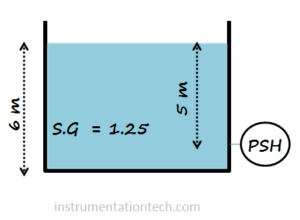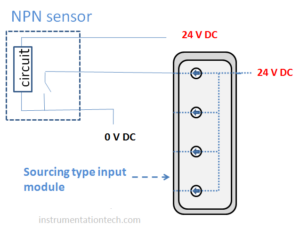Sinking and sourcing concepts
Sinking and sourcing .A simple but a confusing concept among industrial automation experts . especially in industrial automation systems .
In PLC, or other modern control systems these two terms are very important . Because they define how the sensors are to be connected to a digital I/O point .Or what type of sensors must be used for a particular type of I/O modules .
Sinking and Sourcing are terms used to define how the direct current is switched to a load . Before get in to that let us analyze a situation .We have a power source say 24 V ,a switch and a 24 V lamp. How the lamp should connect to the power supply through the switch .????
The 24 V is connected to the lamp .And a switch is connected between the + 24 V and the lamp .See figure
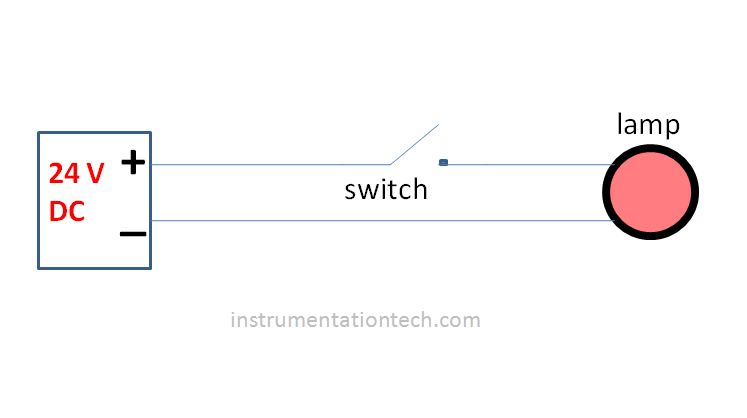
In this type of connection the switch is directly connected to +24V .And it is always on +24 V potential .And the load is connected to ground .The switch provides +24 V to the load when it is closed . Causing current to flow .In this type of connection the switch act as a source . Because it sources the current to the load . And the lamp is called a sinking device which receives the current in to it .
But there is another way to connect the lamp in to the power supply .The switch is connected between the Ground and the load .see figure below
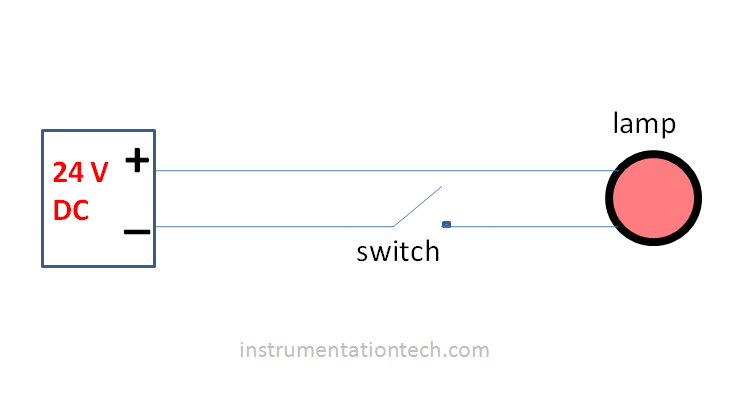
In this type of connection the load is always on the +24 V potential and it needs ground connection for current flow .This connection to ground is provided by the switch .The lamp (load)act as a source and the switch act as a sink here .
So these are the two ways of connection .The circuit works in both case .Lamp glows .So actually what is the difference ?
Note the current flow direction . take current flow direction from +ve to negative by convention .Then we can see that the direction of current flow is different with respect to the load in these two cases .In the above two cases these direction of current flow and connection method are less important.You can choose any of them to operate the lamp .But there are some areas,these connection methods plays important role .
Yes some circuits are designed so that they are sensitive to sinking and sourcing .
Sinking and sourcing in control systems
In control systems like PLC or DCS or any other we can see the above two types of different connection methods . Digital inputs and outputs and their receiving modules are specified on the basis of this . They are called sinking input module ,sourcing input module,sinking output module, sourcing output module etc .
In control systems they usually access the field inputs and outputs through the I/O channels or I/O cards .And there needs to take special care while we are dealing with I/O cards and their wiring concepts .An incorrect wiring will give bad results . One should be aware of types of I/o modules ,field device types and the methods of wiring
Digital or discrete I/o modules
Discrete or digital I/O modules are meant for receiving or sending digital signals .Common discrete levels to the field side are 24 V and 0 V ..Lets see circuit arrangement of a digital input modules .
concepts of the above two examples is the same while we are dealing with wiring concepts of DI cards or DI modules .
Sinking type input cards/ module wiring
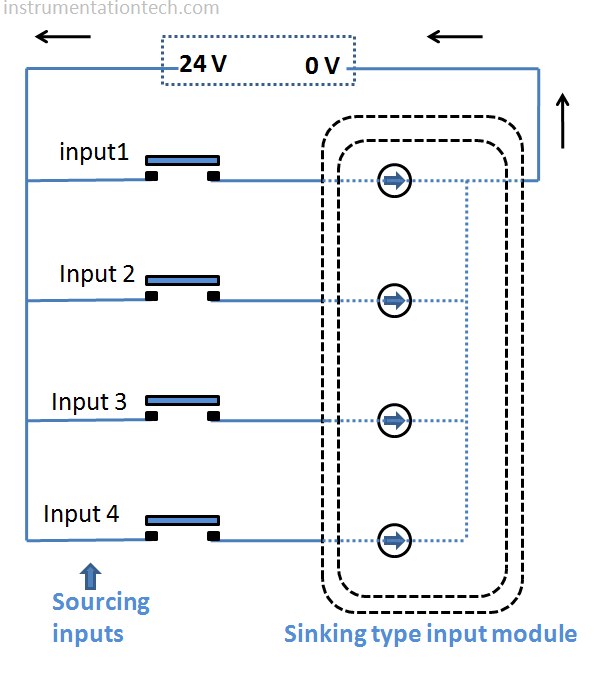
The above diagram shows field inputs connected to a DI module .The DI module is a sinking type .And field inputs are switches (Like pressure switch, temperature switch ,contact status etc)or contacts which tells a status of the field device .They act as sources .All the input channel of the DI module are grounded (0V is common to all).You should note that the direction of the current flow .(conventional current) .It follows the below path .The module is sinking type input module.
+24V .……. input …….. I/O module ……… 0 V
Sourcing type input cards/ module wiring
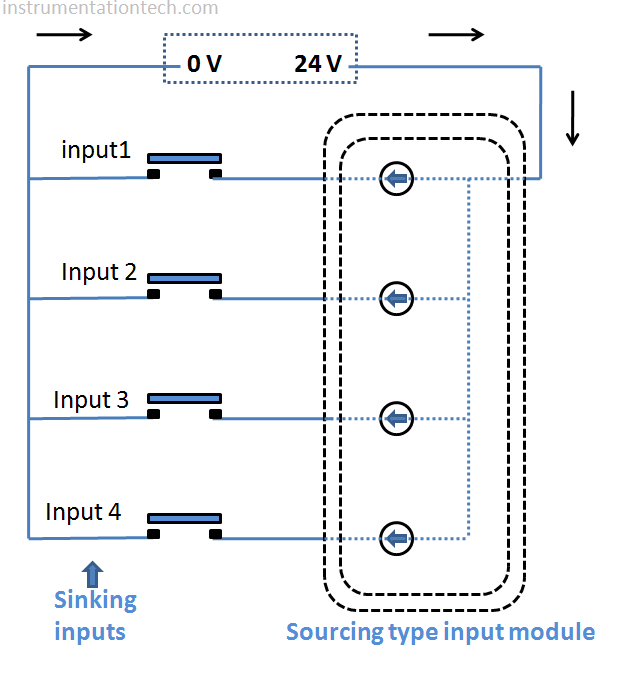
The above diagram shows field inputs connected to a DI module .The DI module is a sourcing type .And field inputs act as sink .All the input channel of the DI module are connected to +24V(24V is common to all).You should note that the direction of the current flow .(conventional current) .It is as follows
+24V ….. I/O module …… input ……0 V
Sourcing and sinking for outputs
we have already learned the Concepts of sinking and sourcing and the basic wiring architecture for inputs and input modules .The same wiring concepts can be applied for the output devices and output card .
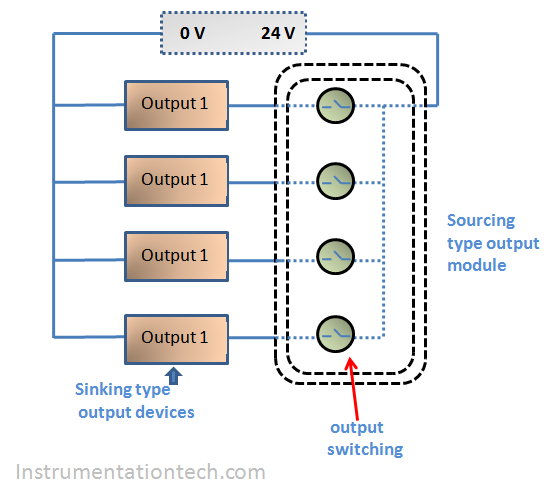
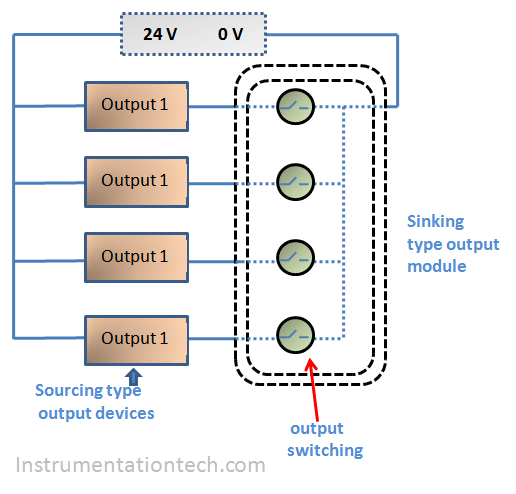
Importance of wiring Concepts
Sinking and sourcing are important especially when connecting field devices to the control panel . And also while doing connections, maintenance, trouble shooting etc . if we didn’t know the wiring concepts then our job will be not so easy.Connecting a sourcing device to a sourcing module will give bad results .Also connecting a sinking device to a sinking module gives the same .As discussed before in this article there is two points you must remember
1.A sourcing device must be connected to a sinking type module
2 .A sinking device must be connected to a sourcing type module
Here some devices can be used as sink or source .For example a contact .It can be connected any of the two input modules .But you should follow the proper wiring concepts .Means if you are connecting it to a sinking input module you must follow its wiring concepts .And if you are connecting it to the sourcing input module you must follow its wiring Concepts .These are already described before in this article .
Some sensors, we can define them specifically as sinking type or sourcing type .That means if it is a sinking type it cannot be used as sourcing type or vice versa . Most common examples are proximity sensors of NPN and PNP type. NPN (sinking type sensor).PNP (Sourcing type sensor)
Some Misconceptions
There are some misconceptions related to sourcing and sinking .Ideas Like
1.Sourcing means giving output or it is related to output card and output devices – wrong concept
2.Sinking means receiving input or it is related to input card and input devices -wrong concept
The above ideas are absolutely wrong . As already mentioned in this article, sourcing and sinking specifies the direction of current flow.And it is applicable to both input and output .
